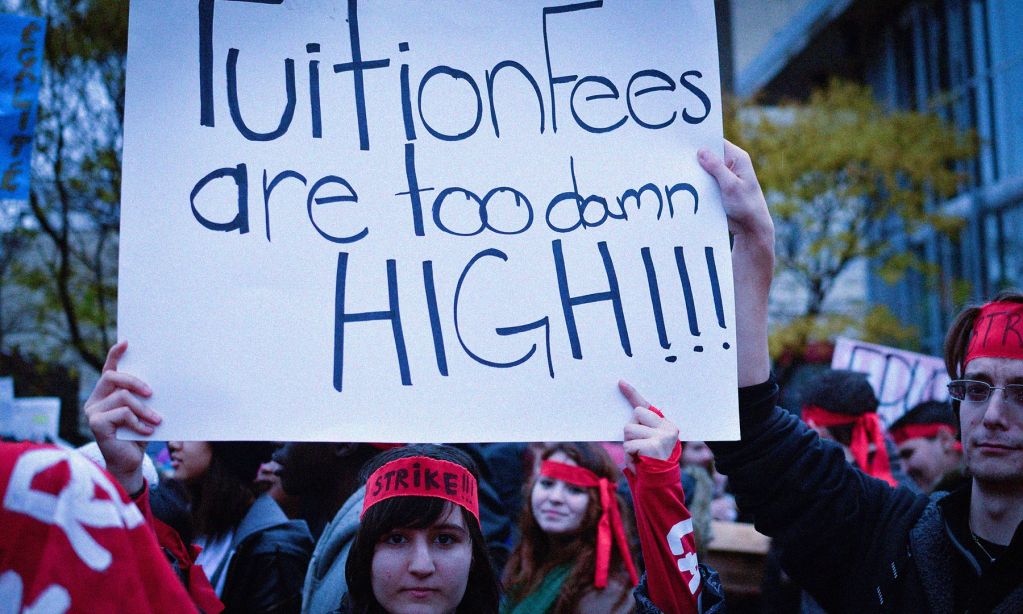Canada’s student debt-driven system of higher education entrenches social and economic inequality by setting many students up for a lifetime of indebtedness, much less wealth, and a greater risk of financial hardship.
When we talk about the student debt crisis, we usually focus on how much debt students and former students owe—about $39 billion as of 2019—or the fact that nearly half of graduates end their time in school with student loans. We often overlook the tremendously negative impacts of student debt on the lives of borrowers, their families, and society at large.
Student debt begets more debt
Student debt creates a need for more debt because student loan payments reduce borrowers’ disposable income early in life when wages are the lowest. To maintain a minimum standard of living, student debtors make up for that lost income by borrowing more—starting a cycle of indebtedness that can be difficult to break. High student loan payments can also limit debtors’ ability to repay other debts, such as credit card debt, leading to growing debts and even more financial stress.
Canadian student loan borrowers who were in their twenties in 2019 owed much more in total debt than those who were student debt free.
Not only are many young workers saddled with debts that will negatively impact them over a lifetime, but there is also evidence that the generational burden goes in both directions. Among households headed by older adults, aged 50 and over, those where anyone in the household owed student debt – mostly the student loans of dependents still living at home – had far higher total debts than those without student debt. This suggests that the financial support many parents provide to their children while studying and after graduation is straining household budgets, leading to higher indebtedness.
Borrowers of student loan debt often have their lifetime opportunities to build wealth, saving potential, and access to credit restricted when they need it the most. Middle-aged student loan borrowers had lower total debts than those without a student loan. However, this is not due to improved financial well-being. Instead, it signifies greatly reduced wealth among those still paying off their loans long after studyings. Student debtors therefore, on average, both start out life with less wealth and end up with less wealth.
Not all debts are created equally
Not all debt is inherently harmful to financial well-being. Some forms, like mortgage debt, purchase major assets like homes. The home equity built up as mortgage debts are paid off is one of the few sources of personal wealth available to most people. Other forms of debt, like much consumer debt, satisfy needs for short-term consumption, but leave little in the way of lasting assets, often draining wealth in the long-term.
Student loan borrowers have less wealth-building types of debt and much more debt for immediate consumption. In particular, student loan borrowers had much higher credit card debts across all age ranges. One reason for this is simply how easy it is for students to access credit card debt, as banks and financial companies focus on getting cards into the hands of students and heavily incentivizing them to borrow early on in life. But it goes far beyond the initial bump in debt.
Most major bill payments in Canada, like mortgages or rent, cannot be easily paid with a credit card, so they are usually paid out of bank accounts. When people without abundant income have cash in the bank, they tend to save it for bills, while using credit cards to pay for more immediate consumption, like buying groceries.
Generally, the larger the proportion of income a person diverts toward bill payments, the more borrowing they need to maintain a minimum standard of living. This logic applies even more to students, given that they are under intense financial pressures during study, followed up by post-graduation reduction of income by student loan repayments. It is no wonder that student loan borrowers often struggle with high credit card debts and are much more likely to carry a monthly card balance forward and incur interest.
By increasing total debts and ramping up debt-to-income ratios, student debt negatively impacts a borrower’s creditworthiness in the eyes of lenders. Getting behind on student loan repayment greatly worsens the damage to a borrower’s credit rating. Student debtors therefore had lower average credit limits on top of higher card balances, leading to higher credit usage rates, which further damages creditworthiness.
All together, the impact is to restrict access to credit and to make the terms of borrowing much less favourable. This credit constraining effect is one of the main ways that student debt limits lifetime opportunities to accumulate wealth, by preventing major milestone purchases like buying a home.
According to the Survey of Financial Security, student debtors were much more likely to report having trouble with credit card use than those who had no student loans. Those who owed student debt were much more likely to pay only the minimum balance on their credit cards, miss card payments due to financial troubles, and own multiple credit cards. This toxic interplay between student and credit card debt has grown into a major source of financial stress and strain for many young Canadians and their families.
As these troubles grow, student debt holders see their creditworthiness degrade and the terms borrowing become even less favourable—leading to increasingly burdensome debt repayment obligations. In such a spot, it's easy to see how many student loan borrowers become trapped in a chain of debt and financial instability that can be difficult to escape. Student debtors were nearly three times as likely to report using a payday loan in the past year, a surefire sign of financial distress.
The burdens of student debt, especially when combined with other forms of high-interest, short-term loans like credit card debts, are playing an increasingly important role in driving young people into bankruptcy. Despite the existence of repayment assistance programs to lighten the repayment burden on low-income borrowers, many student debtors still end up on a slippery slope of debt that ultimately leads to financial ruin.







